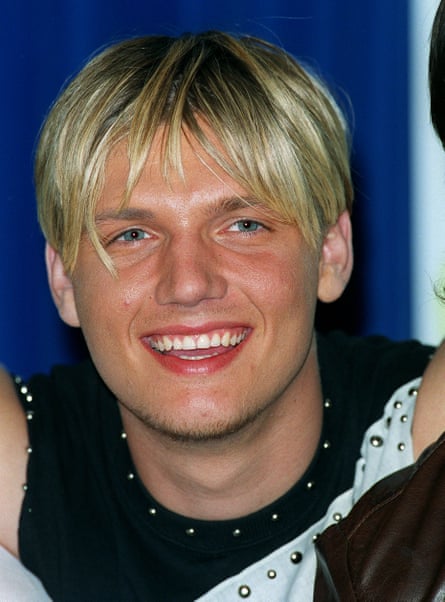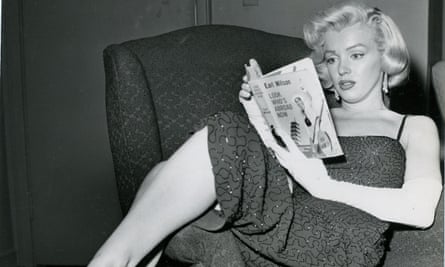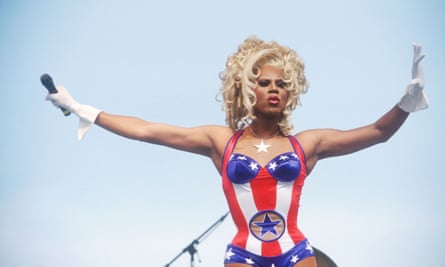My favourite Paris Hilton quote (yes, I have a favourite Paris Hilton quote) is when, in 2006, she told the Sunday Times: “There’s nobody in the world like me. I think every decade has an iconic blond, like Marilyn Monroe or Princess Diana. And right now, I’m that icon.”
It’s an impressive level of chutzpah, and yet, she isn’t wrong. The examples Hilton gave are particularly pertinent in 2022; a recent “fictitious” biopic of Monroe, Blonde, has become one of Netflix’s most-watched originals, and Diana is front and centre in the most recent season of The Crown (in which Elizabeth Debicki appears in a coiffed wig).
In the 1930s, it was Jean Harlow who inspired film fans – and many of her fellow female actors after a brunette-dominated 20s – to hit the bottle. Veronica Lake’s long, blond hair lit up the 1940s, and Grace Kelly became the archetypal “Hitchcock blond” (of which more later) in the 1950s. Dusty Springfield and Twiggy headed up the British invasion in the swinging 60s, while Debbie Harry shot to stardom in the 1970s; in the 80s we had Madonna.
The 90s saw a brief era of light-haired boyband frontmen (the Backstreet Boys’ Nick Carter and ‘N Sync’s Justin Timberlake) adorning bedroom walls. Then, after Hilton and Nicole Richie’s 00s Simple Life, something of a fallow period, with the likes of Cate Blanchett and Gwyneth Paltrow bravely holding the fort.

Every decade has its blonds but now, as we’ve stepped blinking into the sunlight post-pandemic, blondness is back. The revolution started a little before: Billie Eilish ditching her black-and-green signature hair last year on a classic Hollywood-style Vogue cover was a big moment, and in summer 2019 Pinterest saw a 308% rise in searches for “mushroom blonde” – a sort of blond-brunette hybrid also known as “bronde” – while “blond hair” was one of the top search terms on Google and YouTube. Let’s not forget Kim Kardashian, who is (at time of press) somewhere between honey and ice.
This year, “tweed blond”, “ice cube blond”, “rose gold blond” – alongside staples such as ash and platinum – have been everywhere, from celebrity heads to Instagram influencers to sixth-formers and footballers (check out Brazilian stars Neymar and Richarlison’s World Cup looks). So, what’s behind this blond saturation?
Tom Smith is one of the world’s leading hair stylists, with more than 78,000 followers on TikTok, a roster of VIP clients, and plenty of television and film work. He posits that, aside from celebrity and cultural influence, the pandemic and the bleak state of the world has had an accelerant impact on those initial shoots.
“There’s evidence throughout history that during times of economic downturn requests for blond hair increase in popularity,” he tells me. “My theory on this is that blond feels bright, bold and happy. When real life starts to get a little dull, brightening up our hair is one of the easiest and most effective ways of giving us a boost of energy.”
Smith also thinks the uplift in blond-requesting clients is because, during the pandemic, people felt a “newfound appreciation” for their hairstylists and so are now willing to trust them more. This means they are less nervous to try new things – and going blond can be a radical change. “It’s also about hair science,” he says. “New technologies mean that blond is a more viable option for more people.”
Pity the Greeks and Romans, who poisoned themselves with lead in their concocted dyes, or those in medieval times who used pigeon droppings and horse urine as colorants. L’Oréal’s founder, Eugène Schueller, building on the work of an English chemist, William Henry Perkin, created the first chemical dye in the early 20th century and double-processing soon followed. Clairol popularised home colouring in the 1950s, and the science has not stopped evolving since; balayage – the painting of colour by hand– was born in 1970s Paris, but has exploded as a technique in the past decade, while foiling emerged in the 1980s.
Most recently, Smith noticed something he calls “ReBirth blond”, maintaining hair that had been naturally lightened in the summer. It is, Smith says, a subtler take, “a nod to the seamless and organic highlights that children have”.
I was one of those children, until, as is common, my colour dimmed to the much-maligned “mousy brown”. But I have been platinum blonde since I was 18. I was preparing to move abroad and, given that my life was about to change dramatically, I felt my look should too.
Cue my older sister snapping on the latex gloves that came with a shop-bought box dye. The first time resulted in a Ronald McDonald hue, and my scalp felt as though it were on fire. But, otherwise, it did exactly what I was hoping for: announced me as renewed and revitalised, the sort of effect Smith describes. I have been blond ever since.

But maintenance isn’t easy – and it’s expensive. Today, I alternate between salon sessions and DIY; my sister is now a dab hand. The dedication required is something the directors at the award-winning Four salon in Mayfair – who look after the hair of Yasmin Le Bon, Nigella Lawson and Anne-Marie Duff among others – tell me is key for people to consider before choosing to go blond. “We are very mindful of the colour choices and the positioning of the colour application. A big factor is how often the client can visit the salon – it must be manageable for them in terms of maintaining the beauty of the hair colour.”
In other words; it’s a lifestyle. Something I know only too well. Four recommends Color Wow Root Cover-Up, a powder designed to sustain between salon visits, and advises avoiding harsh shampoos, which can easily strip colour. Smith also emphasises the importance of treatment protocols at home. It’s imperative to protect hair from heat (“yes, that includes hot showers!” he says). Reparative masks also help.
The vast majority of blonds will recognise these routines, as just 2-3% of the world’s population is naturally blonde. Blondism – which is the lack of a pigment called eumelanin – is most prevalent in Nordic countries; Finland has the world’s highest incidence at 80% of the population. One theory is that people who grew up in places with little sunlight evolved light hair and skin to aid the synthesis of Vitamin D. Pockets of natural blondism do exist elsewhere – including, perhaps surprisingly, in the archipelagos of the South Pacific.
Blondism has convoluted, and often contradictory, connotations in the western canon. It has, for hundreds of years, been associated with purity, fertility, innocence and beauty, as in much of Norse mythology. In fairytales, innocent blondes abound (think Goldilocks and Rapunzel). In men, blond hair represented health and youthful vigour. It probably doesn’t need to be spelt out that blond as the ideal has led to some dark outcomes.
But in modern times, the ditzy/dumb blond trope is one of the first things that comes to mind. Though one of the first dumb (literally) blonds was French courtesan Rosalie Duthé, who paused for such long times before speaking that she was satirised in a 1775 play. Paris Hilton gave that quote back in 2006 to kick back at a characterisation of vapidity, when she was someone who had shrewdly built up a business empire (and is responsible for Stars Are Blind, which remains an absolute banger).
Marilyn Monroe, who flew her colourist halfway across the country every weekend, was a voracious reader – Dostoevsky was one of her favourites – but she was portrayed as having about two brain cells. I can’t be certain, but when I started out as a young journalist and was met with occasional dismissive attitudes by – mostly male – older colleagues, I did wonder whether it wasn’t just a mix of ageism and misogyny, but also had something to do with my blondness.

Meanwhile, the motif of sexually voracious bombshell – announced in Jean Harlow’s 1933 film of the same name – represents a subversion of the blond as innocent and pure. Perhaps more than anybody, Alfred Hitchcock is responsible for shifting the cultural portrayal of blond women to sexualised and cunning. His obsession with blonds onscreen reflected his appetite for them offscreen. (This was not a healthy obsession, but a controlling and abusive one.)
But do gentlemen really prefer blonds? Anita Loos told an amusing origin story for the title of her 1925 novel. Travelling by train she was unimpressed to find that while she was “allowed to lug heavy suitcases … while men sat about and failed to note my efforts”, when a young, blond woman “happened to drop the novel she was reading, several men jumped to retrieve it”.
When I ask psychologist and Harvard professor Nancy Etcoff about the perceived attractiveness of blondness, she directs me to a section in her seminal book Survival of the Prettiest: The Science of Beauty. While the rarity is undoubtedly an allure, and the idea of blond women standing out goes right back to Palaeolithic times, her book suggests that – perhaps unsurprisingly in a continuing world of racist hierarchies and inequality – blond hair has endured not because of the hair itself, but the accompanying white skin.
Rather fascinating is where the stereotype of blonds as dumb collides with the perception that blonds are more attractive, when repeated studies have shown attractive people are subconsciously judged as more intelligent. As Etcoff’s book asserts, good-looking people often have a much smoother path in life, including professionally.
One study found that blond women earn 7% more than their brunette peers. And while one successful Silicon Valley CEO admitted she dyed her naturally blond hair brown in attempts to avoid prejudice, a 2016 study found that, out of a US population that is 5% naturally blonde, 48% of female chief executives of S&P 500 companies, and 35% of female senators, were blond.
This disproportion doesn’t exist with men. Which leads to another, more depressing, theory: that blond women get ahead in the workplace not because they are viewed as more attractive and therefore more intelligent, but the opposite: because their apparent docile and pliant natures allow them to be easily controlled, even when at the top of professional tree. We’re back to the ditzy blond.

Personally, I can’t imagine not being blond. I know it’s probably in my head, or more accurately on my head, but I feel the phrase Clairol invented in the 1950s might hold true: blonds really do have more fun. (I also wouldn’t turn down a 7% pay rise.) Or, as RuPaul puts it, blond hair just “pops”.
Smith doesn’t think blond is going anywhere in 2023. He predicts that when the new Barbie film drops next summer there will be a clamour for Margot Robbie-inspired locks. Four thinks that brondes and honey blonds will continue to go strong. But I note that Emma D’Arcy, lover of negroni sbagliatos and member of television’s most iconic blond clan, the Targaryens, hit a red carpet last month with a blaze of matching hair. Meanwhile, Jenna Ortega’s jet-black plaits have cast a dark spell over viewers of Wednesday, the hugely popular Addams Family spin-off.
As the Four stylists tell me: “We love celebs who are chameleons when it comes to their colour. It inspires clients to want to change too.”
Not me though. Blond for life.
Stay connected with us on social media platform for instant update click here to join our Twitter, & Facebook
We are now on Telegram. Click here to join our channel (@TechiUpdate) and stay updated with the latest Technology headlines.
For all the latest Education News Click Here
